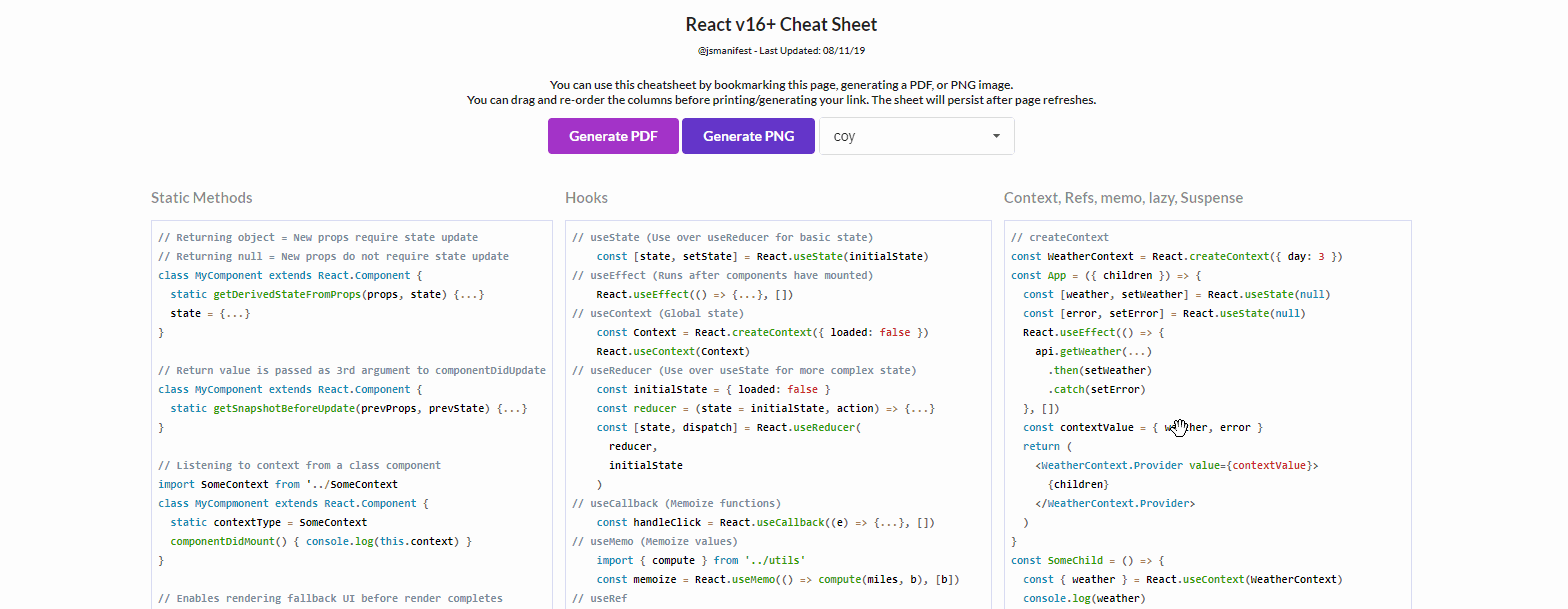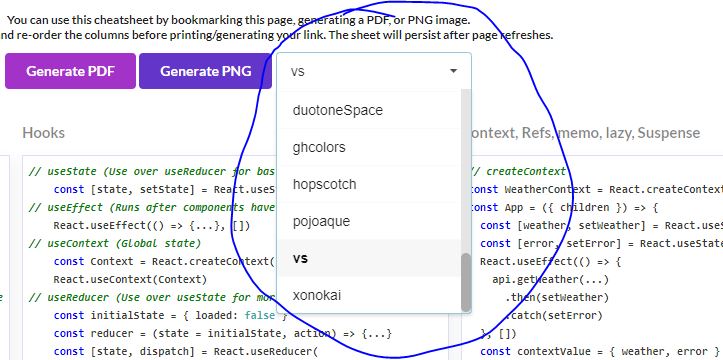This React Cheatsheet Includes All of v16+

This post will go over a cheat sheet that includes react v16 snippets
Sometimes it can take thirty minutes to create a quick interface using React. But sometimes it can also take hours, influenced possibly by many reasons.
If you often forget the names of methods, properties, or the functionality they provide, it can become irritating having to leave your code editor just for a google search. However, is it really that hard to type in a couple of letters and get the answers you want? Well, absolutely not. But if this happens more than once then maybe it's time to acquire a cheat sheet in your possession so that you don't have to leave your code editor anymore. Having a cheat sheet next to you will certainly save you some time in the long run!
Here's a cheat sheet you can use:

While you are looking at the cheat sheet just have in mind that you can:
-
Generate the cheat sheet into a downloadable PDF or PNG, or you can bookmark the page and come back to it at a later time.
-
If you don't like how the columns are ordered you can drag and re-order them before you save the cheat sheet.
-
You can select any of the code syntax themes in the select box to generate in the cheat sheet (there are about 25 themes you can choose):

I will go ahead and put this in a public repo if anyone needs it. I also just began this yesterday so it may not be a perfect cheat sheet, yet.
Also, my goal was to fit all this into one page but there was too much information. If anyone has any suggestions on which parts to swap/remove feel free to let me know.
And the changes will persist after you close your browser so that you don't have to re-do everything.
Here is a full list of what's in the cheat sheet so far (I will keep updating the cheat sheet over time):
Fragments
// Does not support key attribute
const App = () => (
<>
<MyComponent />
</>
)
// Supports key attribute
const App = () => (
<React.Fragment key="abc123">
<MyComponent />
</React.Fragment>
)Return Types
const App = () => 'a basic string' // string
const App = () => 1234567890 // number
const App = () => true // boolean
const App = () => null // null
const App = () => <div /> // react element
const App = () => <MyComponent /> // component
const App = () => [
// array
'a basic string',
1234567890,
true,
null,
<div />,
<MyComponent />,
]Error Boundary (React v16.0)
class MyErrorBoundary extends React.Component {
state = { hasError: false }
componentDidCatch(error, info) {...}
render() {
if (this.state.hasError) return <SomeErrorUI />
return this.props.children
}
}
const App = () => (
<MyErrorBoundary>
<Main />
</MyErrorBoundary>
)Static Methods
// Returning object = New props require state update
// Returning null = New props do not require state update
class MyComponent extends React.Component {
static getDerivedStateFromProps(props, state) {...}
state = {...}
}
// Return value is passed as 3rd argument to componentDidUpdate
class MyComponent extends React.Component {
static getSnapshotBeforeUpdate(prevProps, prevState) {...}
}
// Listening to context from a class component
import SomeContext from '../SomeContext'
class MyCompmonent extends React.Component {
static contextType = SomeContext
componentDidMount() { console.log(this.context) }
}
// Enables rendering fallback UI before render completes
class MyComponent extends React.Component {
state getDerivedStateFromError() {...}
state = { error: null }
componentDidCatch(error, info) {...}
}Component States
// Class component state
class MyComponent extends React.Component {
state = { loaded: false }
componentDidMount = () => this.setState({ loaded: true })
render() {
if (!this.state.loaded) return null
return <div {...this.props} />
}
}
// Function component state (useState/useReducer)
const MyComponent = (props) => {
// With useState
const [loaded, setLoaded] = React.useState(false)
// With useReducer
const [state, dispatch] = React.useReducer(reducer, initialState)
if (!loaded) return null
React.useEffect(() => void setLoaded(true))
return <div {...props} />Rendering Components
// Ways to render Card
const Card = (props) => <div {...props} />
const App = ({ items = [] }) => {
const renderCard = (props) => <Card {...props} />
return items.map(renderCard)
// or return items.map((props) => renderCard(props))
}
const App = (props) => <Card {...props} />
class App extends React.Component {
render() {
return <Card {...this.props} />
}
}
const MyComp = ({ component: Component }) => <Component />
const App = () => <MyComp component={Card} />Default Props
// Function component
const MyComponent = (props) => <div {...props} />
MyComponent.defaultProps = { fruit: 'apple' }
// Class component
class MyComponent extends React.Component {
static defaultProps = { fruit: 'apple' }
render() {
return <div {...this.props} />
}
}Other React Exports
// createContext (React v16.3)
const WeatherContext = React.createContext({ day: 3 })
const App = ({ children }) => {
const [weather, setWeather] = React.useState(null)
const [error, setError] = React.useState(null)
React.useEffect(() => {
api.getWeather(...)
.then(setWeather)
.catch(setError)
}, [])
const contextValue = { weather, error }
return (
<WeatherContext.Provider value={contextValue}>
{children}
</WeatherContext.Provider>
)
}
const SomeChild = () => {
const { weather } = React.useContext(WeatherContext)
console.log(weather)
return null
}
// createRef (Obtain a reference to a react node) (React v16.3)
const App = () => {
const ref = React.createRef()
React.useEffect(() => { console.log(ref.current) }, [])
return <div ref={ref} />
}
// forwardRef (Pass the ref down to a child) (React v16.3)
const Remote = React.forwardRef((props, ref) => (
<div ref={ref} {...props} />
))
const App = () => {
const ref = React.createRef()
return <Remote ref={ref} />
}
// memo (Optimize your components to avoid wasteful renders) (React v16.6)
const App = () => {...}
const propsAreEqual = (props, nextProps) => {
return props.id === nextProps.id
} // Does not re-render if id is the same
export default React.memo(App, propsAreEqual)
Importing
// default export
const App = (props) => <div {...props} />
export default App
import App from './App'
// named export
export const App = (props) => <div {...props} />
import { App } from './App'Pointer Events (React v16.4)
onPointerUp onPointerDown
onPointerMove onPointerCancel
onGotPointerCapture onLostPointerCapture
onPointerEnter onPointerLeave
onPointerOver onPointerOut
const App = () => {
const onPointerDown = (e) => console.log(e.pointerId)
return <div onPointerDown={onPointerDown} />
}React Suspense/Lazy (React v16.6)
// lazy -> Dynamic import. Reduces bundle size
// + Code splitting
const MyComponent = React.lazy(() => import('./MyComponent))
const App = () => <MyComponent />
// Suspend rendering while components are waiting for something
// + Code splitting
import LoadingSpinner from '../LoadingSpinner'
const App = () => (
<React.Suspense fallback={<LoadingSpinner />}>
<MyComponent />
</React.Suspense>
)React Profiler (React v16.9)
const App = () => (
<React.StrictMode>
<div>
<MyComponent />
<OtherComponent />
</div>
</React.StrictMode>
)Synchronous / Asynchronous act Test Utility (React v16.9)
import { act } from 'react-dom/test-utils'
import MyComponent from './MyComponent'
const container = document.createElement('div')
// Synchronous
it('renders and adds new item to array', () => {
act(() => {
ReactDOM.render(<MyComponent />, container)
})
const btn = container.querySelector('button')
expect(btn.textContent).toBe('one item')
act(() => {
button.dispatchEvent(new MouseEvent('click', { bubbles: true }))
})
expect(btn.textContent).toBe('two items')
})
// Asynchronous
it('does stuff', async () => {
await act(async () => {
// code
})
})Conclusion
And that concludes the end of this post! I hope you found this to be useful and look out for more in the future!